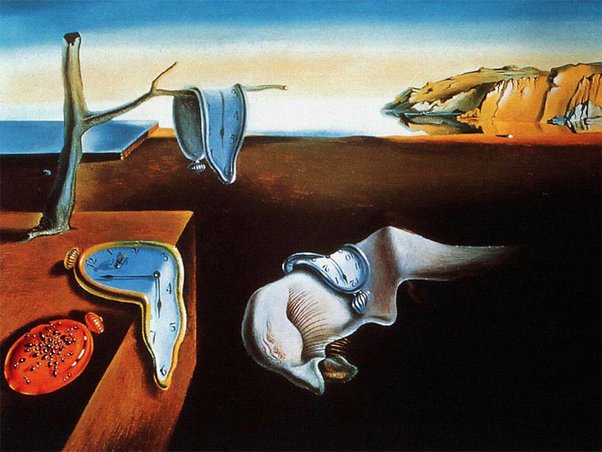The Persistence of Memory- Salvador Dali Oil Paining:
The Persistence of Memory is a 1931 painting by artist Salvador Dalí, and is one of his most recognizable works.
First shown at the Julien Levy Gallery in 1932, the painting has been in the collection of the Museum of Modern Art (MoMA) in New York City since 1934. It is widely recognized and frequently referenced in popular culture.
Description:
The well-known surrealist piece introduced the image of the soft melting pocket watch. It epitomizes Dalí's theory of "softness" and "hardness", which was central to his thinking at the time. As Dawn Ades wrote, "The soft watches are an unconscious symbol of the relativity of space and time, a Surrealist meditation on the collapse of our notions of a fixed cosmic order".
This interpretation suggests that Dalí was incorporating an understanding of the world introduced by Albert Einstein's Special Theory of Relativity. Asked by Ilya Prigogine whether this was in fact the case, Dalí replied that the soft watches were not inspired by the theory of relativity, but by the surrealist perception of a Camembert cheese melting in the sun.
Although fundamentally part of Dalí's Freudian phase, the imagery precedes his transition to his scientific phase by fourteen years, which occurred after the atomic bombings of Hiroshima and Nagasaki in 1945. (The Persistence of Memory- Salvador Dali Oil Paining)
Salvador Dalí. The Persistence of Memory. 1931
It is possible to recognize a human figure in the middle of the composition, in the strange "monster" that Dalí used in several period pieces to represent himself – the abstract form becoming something of a self-portrait, reappearing frequently in his work. The orange clock at the bottom left of the painting is covered in ants. Dalí often used ants in his paintings as a symbol for death.
The figure in the middle of the picture can be read as a "fading" creature, one that often appears in dreams where the dreamer cannot pinpoint the creature's exact form and composition. One can observe that the creature has one closed eye with several eyelashes, suggesting that the creature is also in a dream state. The iconography may refer to a dream that Dalí himself had experienced, and the clocks may symbolize the passing of time as one experiences it in sleep or the persistence of time in the eyes of the dreamer .
The Persistence of Memory employs "the exactitude of realist painting techniques" to depict imagery more likely to be found in dreams than in waking consciousness.
Landscape:
The craggy rocks to the right represent a tip of Cap de Creus peninsula in north-eastern Catalonia. Many of Dalí's paintings were inspired by the landscapes of his life in Catalonia. The strange and foreboding shadow in the foreground of this painting is a reference to Mount Pani.
Versions:
Dalí returned to the theme of this painting with the variation The Disintegration of the Persistence of Memory (1954), showing his earlier famous work systematically fragmenting into smaller component elements, and a series of rectangular blocks which reveal further imagery through the gaps between them, implying something beneath the surface of the original work; this work is now in the Dalí Museum in St. Petersburg, Florida, while the original Persistence of Memory remains at the Museum of Modern Art in New York City. Dalí also produced various lithographs and sculptures on the theme of soft watches late in his career. Some of these sculptures are the Persistence of Memory, the Nobility of Time, the Profile of Time and the Three Dancing Watches.
Salvador Dali was born May 11, 1904 in Figueres, Spain. From an early age Dali was encouraged to practice his art and would eventually go on to study at an academy in Madrid. In the 1920's Dali went to Paris and began interacting with Picasso, Magritte, and Miro leading to his first Surrealist phase. The rise of the fascist leader Franco in Spain led to Dali's expulsion from the Surrealist movement, but that did not prevent him from painting
Refer to: http://en.wikipedia.org/wiki/The_Persistence_of_Memory
Edited by Kevin from Xiamen Romandy Art Limited.
(Xiamen Romandy Art is a professional oil paintings supplier from China. If you want to convert your photos into high quality oil paintings, or you want the masterpiece oil painting reproductions, please don's hesitate to contact with us.)
Romandy Art Website: http://www.oilpaintingcentre.com
Tags: The Persistence of Memory- Salvador Dali Oil Paining
|